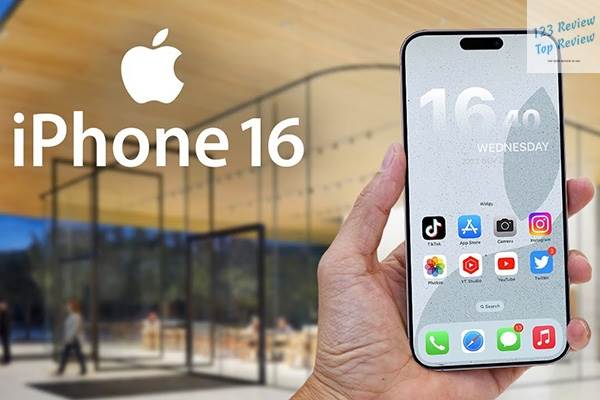As the iPhone 16 looms on the horizon, the buzz surrounding its release is reaching a fever pitch. Apple’s next flagship device is expected to bring a host of new features, advanced technology, and design refinements. Naturally, one of the most critical aspects for potential buyers is the price. With each new iPhone, Apple carefully adjusts its pricing strategy to reflect the value of the innovations offered, while also taking into account market trends and economic conditions.
In this article, 123 Review delves into the expected pricing of the iPhone 16 across its various models in the United States, compares these prices with previous iterations, and explores how Apple’s pricing stacks up against competitors.
Expected Pricing for iPhone 16 Models
Apple’s iPhone lineup has consistently offered a range of models to cater to different consumer needs, from the standard version to the high-end Pro and Pro Max models. Each model offers varying levels of technology, performance, and storage options, which are reflected in their pricing.
Standard iPhone 16 Pricing
The standard iPhone 16 is expected to appeal to the broadest segment of the market, blending premium features with a more accessible price point. Historically, Apple’s standard models have struck a balance between innovation and affordability, making them popular among a wide demographic.

For the iPhone 16, industry analysts predict a starting price between $799 and $849, depending on the base storage capacity and any new features that might be introduced. This pricing range keeps the standard model competitive with other flagship smartphones while still offering the quality and performance that Apple is known for. The inclusion of the latest A-series chip, likely the A18, along with camera enhancements and improved battery life, are all expected to justify this pricing tier.
iPhone 16 Pro and Pro Max Pricing
For users who demand the pinnacle of smartphone technology, the iPhone 16 Pro and Pro Max are the go-to options. These models are typically outfitted with the most advanced features, including superior camera systems, higher refresh rate displays, and cutting-edge materials like ceramic shield fronts and stainless steel frames.
The iPhone 16 Pro is projected to start at approximately $1,099, a slight increase from its predecessor, while the Pro Max could begin at around $1,199. The price difference between the Pro and Pro Max versions is generally attributed to the larger screen size and enhanced battery capacity of the Pro Max, along with any exclusive features that Apple may introduce for this top-tier model. Given Apple’s history, these prices are likely to be well-received by the market, as they continue to offer substantial value in terms of both technology and brand prestige.
iPhone 16 Plus Pricing
Positioned between the standard and Pro models, the iPhone 16 Plus caters to users who prefer a larger display without the full expense of a Pro model. The iPhone 16 Plus is expected to start at a price point between $899 and $949, making it an attractive option for those who want a larger screen but don’t necessarily need all the high-end features of the Pro models.
The iPhone 16 Plus typically includes a larger battery and display compared to the standard model, but it may lack some of the advanced features found in the Pro versions, such as the ProMotion display or the LiDAR scanner. This model allows Apple to offer a middle ground for customers who prioritize screen size but are conscious of budget, effectively filling a niche in the market.
Variations in Pricing by Storage Option
Apple has long offered its iPhones in multiple storage configurations, allowing customers to choose the model that best suits their needs. The iPhone 16 is expected to be no different, with storage options likely ranging from 128GB at the lower end to 1TB at the top.
The base model price typically increases by $100 to $200 as you move up each storage tier. For example, if the 128GB standard iPhone 16 is priced at $799, the 256GB version could cost $899, the 512GB might be $1,099, and the 1TB model could reach $1,299. These incremental price increases reflect the added value of more storage, particularly as users continue to demand more space for high-resolution photos, 4K videos, and large app libraries. This pricing structure also allows Apple to cater to different consumer needs and budgets within the same product lineup.
Comparison with Previous Models
Apple’s pricing strategy has evolved over the years, with each new model reflecting not only the cost of new technologies but also broader market and economic conditions. Understanding the expected price of the iPhone 16 requires looking back at how prices have shifted over previous generations.
Price Changes from iPhone 15 to iPhone 16
Comparing the iPhone 16 with its immediate predecessor, the iPhone 15, offers insights into Apple’s approach to pricing in the current market. The iPhone 15 was generally well-received, with prices ranging from $799 for the standard model to $1,199 for the Pro Max. For the iPhone 16, consumers can anticipate a price increase of approximately $50 to $100 across most models.
This incremental rise can be attributed to several factors, including the introduction of new features, improvements in processing power, and potentially higher production costs. Apple typically justifies these price increases with tangible upgrades, such as a more powerful A18 chip, enhanced camera systems, and possibly the inclusion of new technologies like a more advanced Face ID system or under-display fingerprint sensors.
Historical Price Trends for iPhone Lineup
Looking at the broader history of iPhone pricing reveals a clear trend of gradual increases, reflecting both inflation and the growing complexity and capability of the devices. From the iPhone X onward, Apple has consistently pushed the boundaries of smartphone pricing, with the introduction of the Pro models solidifying its presence in the ultra-premium segment.
For instance, the iPhone X, launched in 2017, marked a significant price jump, starting at $999 for the base model. This trend continued with subsequent releases, as Apple introduced more sophisticated technology, such as OLED displays, advanced biometrics, and increasingly powerful processors. The iPhone 16’s pricing is expected to follow this established pattern, ensuring that Apple remains at the forefront of the premium smartphone market.
Factors Influencing Price Differences
Several factors contribute to the differences in pricing between iPhone models, and between different generations of iPhones. First and foremost is the inclusion of new technologies—each new iPhone typically features a more advanced processor, improved cameras, and other hardware upgrades that drive up costs. Additionally, Apple’s commitment to premium materials, such as stainless steel frames and ceramic shields, adds to the production cost.
Economic factors also play a significant role. Inflation, exchange rates, and changes in global supply chains can all impact the final retail price. For example, fluctuations in the cost of components like semiconductors or OLED displays could result in higher production costs, which are often passed on to the consumer. Apple’s ability to manage these factors while maintaining a premium product is a key aspect of its pricing strategy.
Price Competitiveness in the Market
Apple’s pricing strategy for the iPhone 16 will not only be compared to previous iPhone models but also to its competitors. The smartphone market is fiercely competitive, with major players like Samsung and Google offering high-end devices that often undercut Apple’s prices.
Positioning Against Samsung and Google Phones
In the premium smartphone segment, Samsung and Google are Apple’s primary competitors. Samsung’s Galaxy series, particularly the S and Z lines, offer similar levels of performance and innovation, often at slightly lower prices. Google’s Pixel phones, known for their exceptional camera capabilities and clean Android experience, are also a significant contender, especially with the introduction of features like Google’s custom Tensor chips.
Apple’s iPhone 16 will likely be positioned at a higher price point than comparable Samsung and Google models. However, Apple’s ecosystem—comprising iOS, the App Store, iCloud, and other services—offers significant value that can justify the higher cost. Furthermore, Apple’s strong brand loyalty and the seamless integration between its devices continue to give it an edge in the premium market, allowing it to command higher prices without losing market share.
Pricing Strategies in a Competitive Landscape
In this competitive landscape, Apple’s pricing strategy for the iPhone 16 will be crucial. Apple often justifies its premium pricing through a combination of cutting-edge technology, design excellence, and a tightly integrated ecosystem. The company also employs various strategies to make its devices more accessible, such as trade-in programs, financing options, and bundling services like Apple One, which packages iCloud, Apple Music, Apple TV+, and more at a discounted rate.
These strategies help mitigate the impact of high upfront costs and can make the iPhone 16 more appealing to a broader audience, including those who might otherwise consider more affordable options from competitors. By offering value beyond just the hardware, Apple ensures that its pricing remains competitive, even at the higher end of the market.
Impact of Economic Factors on Pricing
Economic conditions play a significant role in determining the final retail price of the iPhone 16 in the United States. Factors such as inflation, currency fluctuations, and changes in consumer spending habits can all influence Apple’s pricing decisions. For example, in periods of high inflation, the cost of materials and production may rise, leading to higher retail prices.
Similarly, currency exchange rates can affect pricing in international markets, but these changes can also ripple into the U.S. market. If the U.S. dollar strengthens against other currencies, Apple may see reduced costs for imported components, which could help offset other rising costs. Conversely, economic downturns or increased price sensitivity among consumers might prompt Apple to adopt more aggressive pricing strategies or increase promotional offers to maintain sales momentum.
Potential Price Increases
While the expected pricing for the iPhone 16 suggests only modest increases over previous models, several factors could lead to more significant price hikes. Understanding these potential influences is key to anticipating how much consumers might end up paying for Apple’s latest device.
Supply Chain Factors Affecting Costs
The global supply chain has faced unprecedented challenges in recent years, and these issues continue to impact the tech industry. Shortages of critical components, such as semiconductors, have driven up costs and led to delays in production. Apple, despite its vast resources and strong supplier relationships, is not immune to these challenges.
If supply chain disruptions persist, particularly in regions where key components are manufactured, Apple could face increased production costs that may be passed on to consumers in the form of higher prices. Additionally, logistical challenges, such as shipping delays and increased freight costs, could further strain the supply chain, contributing to potential price increases for the iPhone 16.
Material and Production Cost Increases
The materials used in manufacturing the iPhone 16, such as rare earth elements for components and advanced materials for the display and casing, are subject to price volatility. Rising costs of raw materials, driven by increased demand and geopolitical tensions, can lead to higher production costs. For example, the cost of OLED displays, which Apple uses in its Pro models, has been on the rise, and any further increases could be reflected in the retail price.
Labor costs are another factor, especially as wages in manufacturing hubs like China continue to rise. Apple’s commitment to ethical production practices and its push for more sustainable materials may also contribute to higher production costs, which could result in price increases for the iPhone 16.
Implications of Global Economic Conditions
Global economic conditions, including inflation rates, trade policies, and economic growth forecasts, will all play a role in shaping the price of the iPhone 16 in the United States. For instance, if inflation remains high, consumers may face higher prices across the board, not just for iPhones but for a wide range of goods and services. In such a scenario, Apple may need to carefully balance its pricing strategy to avoid alienating price-sensitive customers.
Conversely, if the global economy experiences a downturn, with reduced consumer spending and increased economic uncertainty, Apple might be compelled to adjust its pricing or offer more aggressive promotions to maintain sales volumes. The company’s ability to navigate these complex economic conditions while preserving its premium brand image will be critical to the success of the iPhone 16.
Conclusion
The pricing of the iPhone 16 in the United States is expected to reflect a careful balance between innovation, market competition, and economic realities. While modest price increases are anticipated across the various models, Apple’s strong brand, integrated ecosystem, and strategic pricing initiatives are likely to maintain its position as a leader in the premium smartphone market.
As always, the exact pricing will depend on a myriad of factors, including the introduction of new technologies, supply chain dynamics, and broader economic conditions. Consumers looking to purchase the iPhone 16 can expect to pay a premium for the latest advancements in mobile technology, but with the reassurance that they are investing in a product backed by Apple’s legacy of quality and innovation.




